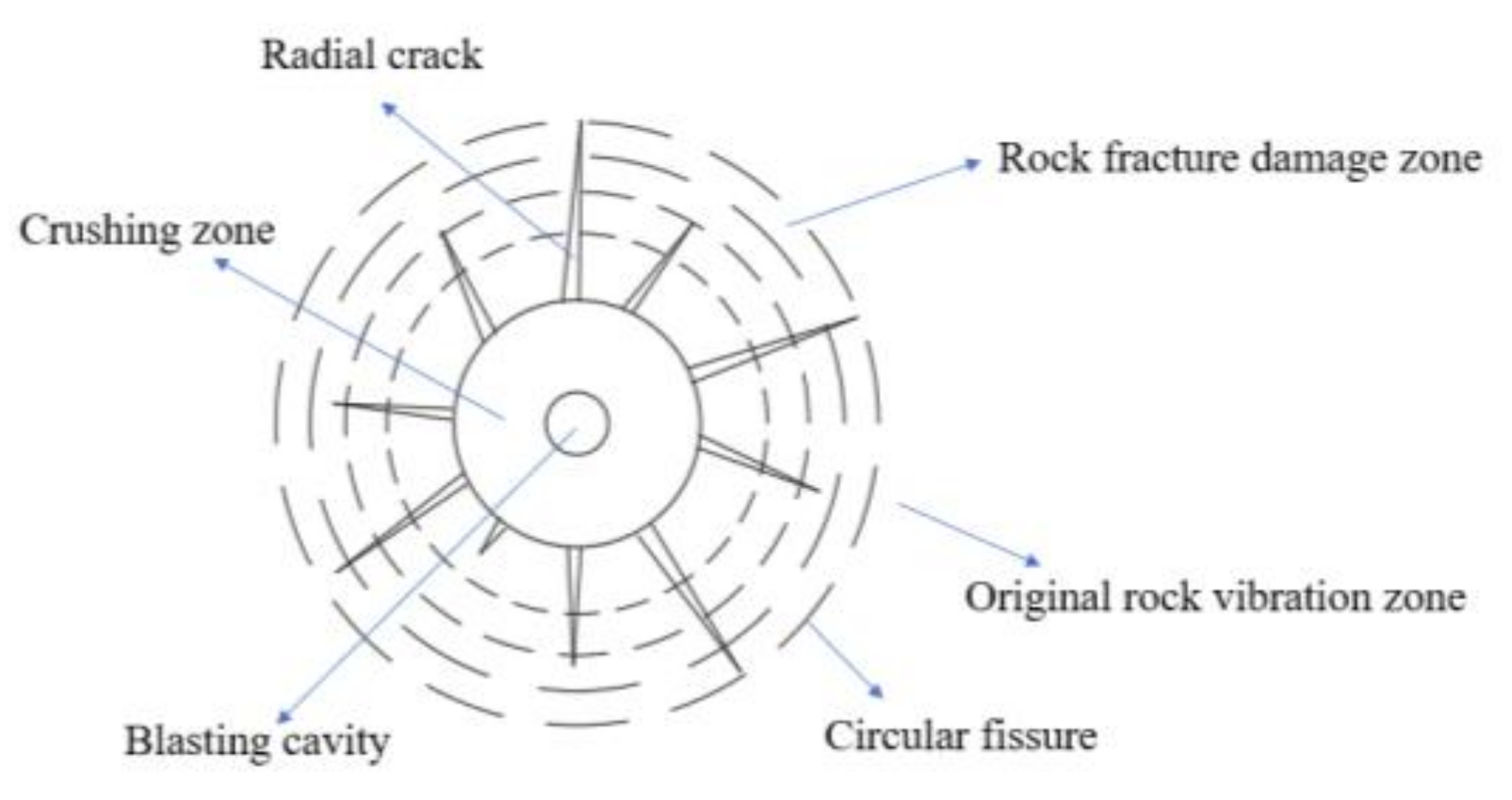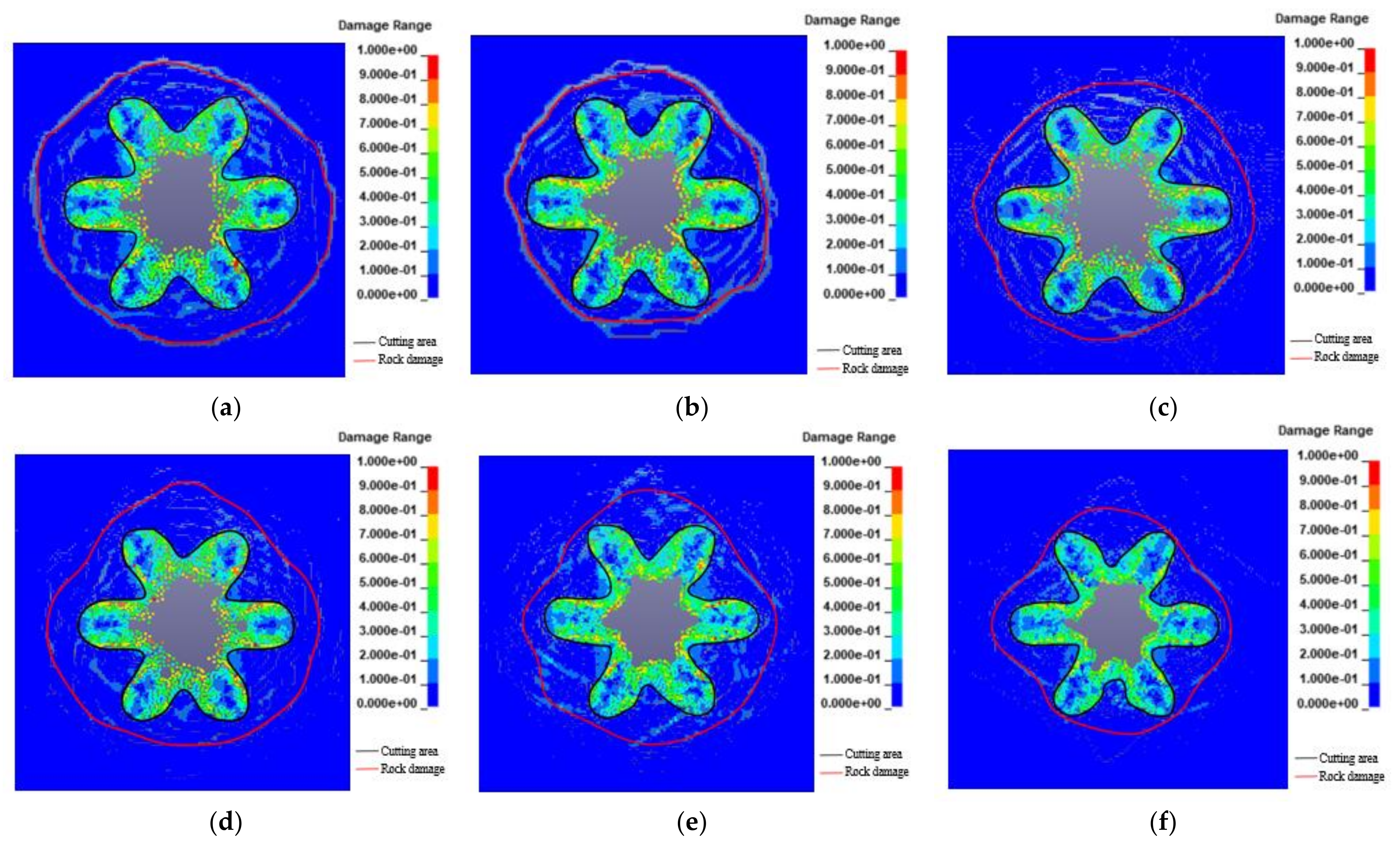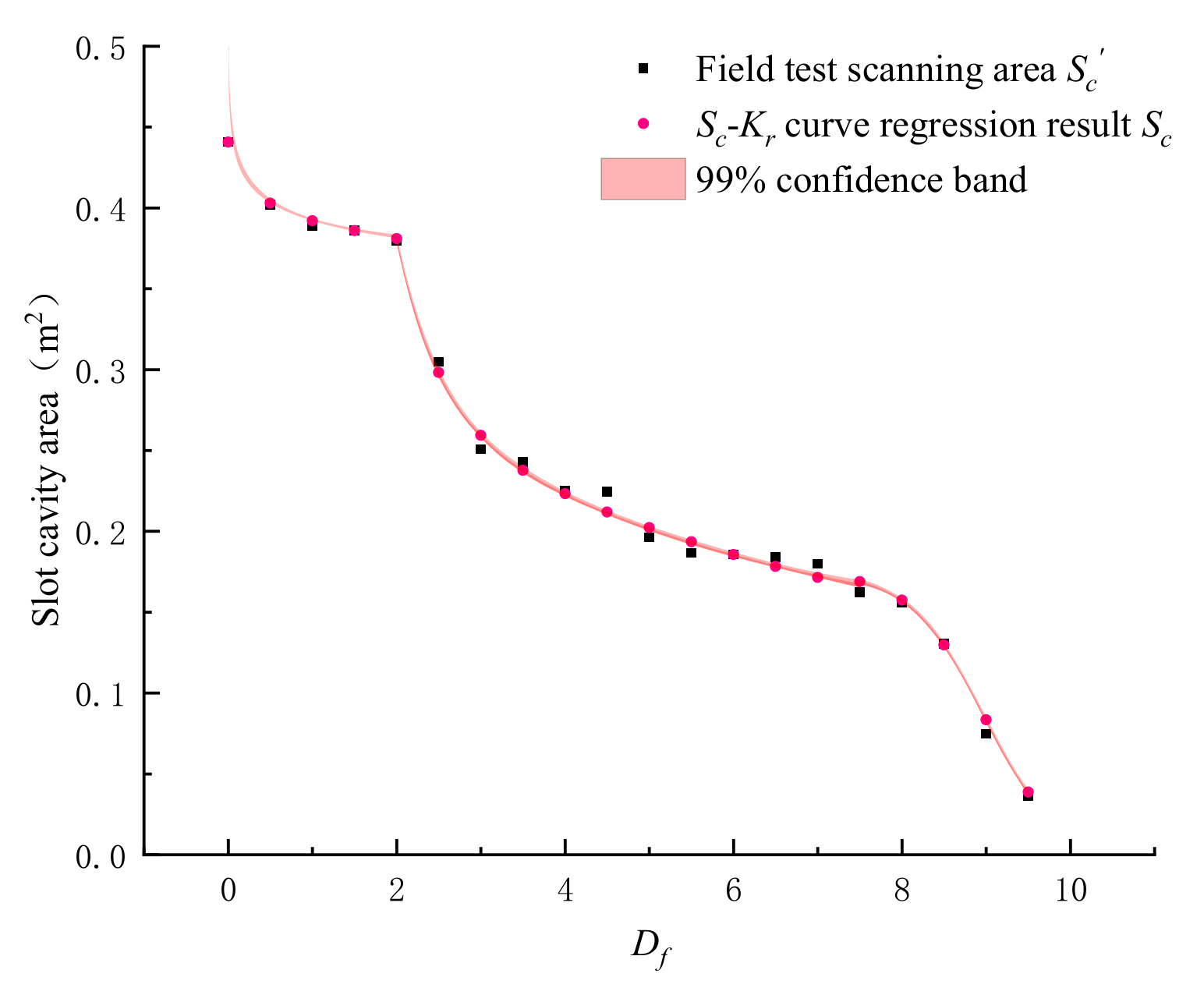Research on Deep-Hole Cutting Blasting Efficiency in Blind Shafting with High In-Situ Stress Environment Using the Method of SPH
Abstract
:1. Introduction
2. Establishment of RHT Constitutive Damage Criterion
2.1. Blast Damage Variable Definition
2.2. Blast Damage Action Zoning
2.3. RHT Constitutive Damage Criterion
3. Field Cutting Blasting Test
4. Numerical Simulation Analysis for Rock Clip Production
4.1. Numerical Model
4.2. Stress Application Method
4.3. Stress Condition Analysis
4.4. Explosive Constitution
4.5. Clamping Factor Simulation Analysis
5. Analysis of the Influence Law of Rock Clamping
6. Discussion
7. Conclusions
- (1)
- Through the calculation of blast breaking strain mechanism and rock damage theory, combined with the embedded function in the RHT damage constitution, the connection between the critical parameters of rock blast damage and material plastic strain, ultimate strain and ontological in the RHT constitution is obtained. The parameters of sodic lava in the numerical simulation are derived based on the RHT constitution parameters of variable sodic lava obtained from mechanical tests and theoretical calculations. The critical threshold of rock damage in the numerical simulation provides a more practical evaluation tool for the damage assessment of RHT constitution in numerical simulation.
- (2)
- The simulation effect of cutting blasting under different rock clamping conditions shows that: rock clamping production inhibits the development and expansion of blast cracks, the stress applied in the numerical simulation affects the extent of fracture generation and development, and the blast produces mainly circular fractures, the larger the coefficient of rock clamping, the greater the blast inhibition effect. Furthermore, the fewer blast cracks and the smaller the rock damage circle.
- (3)
- The rock clamping production in the test area was simulated and compared and inferred according to the field test scanning results to approach the rock clamping production in the field test area. The regression analysis was performed for the rock clamping production coefficient Kr for different depths of the slot cavity to obtain the relationship between Kr and the free surface depth Df, and the relationship between the slot cavity area Sc of the hollowing section and Kr, the mathematical relationship between Sc and Df is obtained, and the goodness of fit of the curve is about 0.94, which fully proves that the Sc-Df curve has high accuracy and provides a reference basis for the relevant design of subsequent deep burial projects.
- (4)
- According to the comparison between the 3D scan data of field trenching and blasting and the numerical simulation results, the average fit of the numerical simulation is 94.5%, which indicates that the RHT parameters have certain accuracy and the numerical simulation has certain reliability.
Author Contributions
Funding
Institutional Review Board Statement
Informed Consent Statement
Data Availability Statement
Conflicts of Interest
References
- Wang, S.; Tang, Y.; Li, X.; Du, K. Analyses and predictions of rock cuttabilities under different confining stresses and rock properties based on rock indentation tests by conical pick. Trans. Nonferrous Met. Soc. 2021, 31, 1766–1783. [Google Scholar] [CrossRef]
- Wang, S.; Li, X.; Yao, J.; Gong, F.; Li, X.; Du, K.; Tao, M.; Huang, L.; Du, S. Experimental investigation of rock breakage by a conical pick and its application to non-explosive mechanized mining in deep hard rock. Int. J. Rock Mech. Min. Sci. 2019, 21, 104063. [Google Scholar] [CrossRef]
- Wang, S.; Sun, L.; Li, X.; Wang, S.; Du, K.; Li, X.; Feng, F. Experimental investigation of cuttability improvement for hard rock fragmentation using conical cutter. Int. J. Geomech. 2021, 21, 06020039. [Google Scholar] [CrossRef]
- Wang, S.; Tang, Y.; Wang, S. Influence of brittleness and confining stress on rock cuttability based on rock indentation tests. J. Cent. South Univ. 2021, 28, 2786–2800. [Google Scholar] [CrossRef]
- Song, Z.; Wang, Y.; Konietzky, H.; Cai, X. Mechanical behavior of marble exposed to freeze-thaw-fatigue loading. Int. J. Rock Mech. Min. Sci. 2021, 138, 104648. [Google Scholar] [CrossRef]
- Yan, P.; Lu, W.; Li, H.; Chen, M.; Zhou, C. Influence of geo-stress on energy distribution of vibration induced by blasting excavation. Explos. Shock. Waves 2009, 29, 182–188. [Google Scholar]
- Wei, C.; Zhu, W.; Bai, Y.; Niu, L. Numercial simulation on cutting seam cartridge blasting under different in-situ stress conditions. Explos. Shock. Waves 2016, 36, 161–169. [Google Scholar]
- Yang, J.; Sun, W.; Yao, C.; Zhang, X. Mechanism of rock fragmentation by multi-hole blasting in highly-stressed rock masses. Explos. Shock. Waves 2020, 40, 118–127. [Google Scholar]
- Yang, J.; Wu, Z.; Yao, C.; Jiang, S.; Jiang, Q. Influence of in-situ stress on blast-induced rock fracture and seismic waves. J. Vib. Shock. 2020, 39, 64–70. [Google Scholar]
- Liu, Z.; He, C.; Fu, G. Numerical simulation and properties of in-situ stress field on roadway surrounding rock failure. J. Heilongjiang Univ. Sci. Technol. 2018, 28, 14–18. [Google Scholar]
- Dai, J.; Qian, Q. Break blasting parameters for driving a roadway in rock with high residual stress. Explos. Shock. Waves 2007, 27, 272–277. [Google Scholar]
- Tang, H.; Zhou, Y.; Liao, Y. Damage zone of surrounding rock of underground engineering under construction blasting. J. Vib. Shock. 2015, 34, 202–206. [Google Scholar]
- Tao, M.; Li, X.; Wu, C. 3D numerical model for dynamic loading-induced multiple fracture zones around underground cavity faces. Comput. Geotech. 2013, 54, 33–45. [Google Scholar] [CrossRef] [Green Version]
- Li, X.; Cao, W.; Zhou, Z.; Zou, Y. Influence of stress path on excavation unloading response. Tunn. Undergr. Space Technol. 2014, 42, 237–246. [Google Scholar] [CrossRef]
- Li, X.; Cao, W.; Tao, M.; Zhou, Z.; Chen, Z. Influence of unloading disturbance on adjacent tunnels. Int. J. Rock Mech. Min. Sci. 2016, 84, 10–24. [Google Scholar] [CrossRef]
- Cao, W.; Li, X.; Tao, M.; Zhou, Z. Vibrations induced by high initial stress release during underground excavations. Tunn. Undergr. Space Technol. 2016, 53, 78–95. [Google Scholar] [CrossRef]
- Yang, D.; Li, H.; Xia, X.; Luo, C. Study of blasting-induced dynamic damage of tunnel surrounding rocks under high in-situ stress. Rock Soil Mech. 2014, 35, 1110–1116. [Google Scholar]
- Luo, S.; Yan, P.; Lu, W.; Chen, M.; Wang, G. Research on the simulation of blasting damage and its mechanism of deep tunnel excavation. Chin. J. Rock Mech. Eng. 2021, 40, 2760–2772. [Google Scholar]
- Chen, M.; Hu, Y.; Lu, W.; Yan, P.; Zhou, C. Numerical simulation of blasting excavation induced damage to deep tunnel. Rock Soil Mech. 2011, 32, 1531–1537. [Google Scholar]
- Lu, W.; Yang, J.; Chen, M.; Zhou, C. Mechanism and equivalent numerical simulation of transient release of excavation load for deep tunnel. Chin. J. Rock Mech. Eng. 2011, 30, 1089–1096. [Google Scholar]
- Li, Q.; Liu, K.; Li, Q.; Wang, Z.; Weng, L. Cutting parameter optimization for one-step shaft excavation technique based on parallel cutting method. Trans. Nonferrous Met. Soc. China 2018, 28, 1413–1423. [Google Scholar] [CrossRef]
- Xiao, S.; Jiang, Y.; Liu, Z.; Su, L. Hard rock blasting energy distribution and fragmentation characteristics under high earth stress. J. Vib. Shock. 2018, 37, 143–149. [Google Scholar]
- Wu, Z.; Zhang, C. Investigation of rock damage model and its mechanical behavior. Chin. J. Rock Mech. Eng. 1996, 15, 55–61. [Google Scholar]
- Riedel, W.; Kawai, N.; Kondo, K.I. Numerical assessment for impact strength measurements in concrete materials. Int. J. Impact Eng. 2009, 36, 283–293. [Google Scholar] [CrossRef] [Green Version]
- Brown, E.T.; Hoek, E. Technical note trends in relationships between measured in-situ stress and depth. Int. J. Rock Mech. Min. Sci. Geomech. Abstr. 1978, 15, 211–215. [Google Scholar] [CrossRef]
- Fuchs, K.; Müller, B. World Stress Map of the Earth: A key to tectonic processes and technological applications. Die Nat. 2001, 88, 357–371. [Google Scholar] [CrossRef]










| Damage Zone | Rock Damage Volume D | Blasting Center Distance r/m |
|---|---|---|
| Crushing zone | D = 1 | r < r0 |
| Partition threshold | 1 | r0 |
| fracture and damage zone | Dcr < D < 1 | r0 < r < r1 |
| Partition threshold | Dcr | r1 |
| Primary rock stress zone | D ≤ Dcr | r > r1 |
| Constitutive Parameters | Parameter Values | Access Approaches |
|---|---|---|
| ρ/kg/m3 | 2860 | testing methods |
| fc/MPa | 41.5 | uniaxial compression test |
| fs* | 0.09 | theoretical calculation |
| ft* | 0.02 | |
| G/GPa | 3.8 | |
| βc | 0.028 | |
| βt | 0.033 | |
| gc* | 0.53 | Constitutive self-contained |
| gt* | 0.70 | |
| Q0 | 0.681 | |
| B | 0.011 | |
| D1 | 0.04 | |
| D2 | 1 |
| Density/kg/m3 | Detonation Velocity/m/s | C-J Pressure/GPa | Ferocity/mm | Blasting Force/mL | JWL State Equation Parameters | ||||
|---|---|---|---|---|---|---|---|---|---|
| A/GPa | B/GPa | R1 | R2 | ω | |||||
| 950 | 2800 | 6.5 | 18 | 280 | 326 | 5.8 | 5.80 | 1.56 | 0.57 |
Publisher’s Note: MDPI stays neutral with regard to jurisdictional claims in published maps and institutional affiliations. |
© 2021 by the authors. Licensee MDPI, Basel, Switzerland. This article is an open access article distributed under the terms and conditions of the Creative Commons Attribution (CC BY) license (https://creativecommons.org/licenses/by/4.0/).
Share and Cite
Sun, B.; Zhang, Z.; Meng, J.; Huang, Y.; Li, H.; Wang, J. Research on Deep-Hole Cutting Blasting Efficiency in Blind Shafting with High In-Situ Stress Environment Using the Method of SPH. Mathematics 2021, 9, 3242. https://doi.org/10.3390/math9243242
Sun B, Zhang Z, Meng J, Huang Y, Li H, Wang J. Research on Deep-Hole Cutting Blasting Efficiency in Blind Shafting with High In-Situ Stress Environment Using the Method of SPH. Mathematics. 2021; 9(24):3242. https://doi.org/10.3390/math9243242
Chicago/Turabian StyleSun, Bo, Zhiyu Zhang, Jiale Meng, Yonghui Huang, Hongchao Li, and Jun Wang. 2021. "Research on Deep-Hole Cutting Blasting Efficiency in Blind Shafting with High In-Situ Stress Environment Using the Method of SPH" Mathematics 9, no. 24: 3242. https://doi.org/10.3390/math9243242
APA StyleSun, B., Zhang, Z., Meng, J., Huang, Y., Li, H., & Wang, J. (2021). Research on Deep-Hole Cutting Blasting Efficiency in Blind Shafting with High In-Situ Stress Environment Using the Method of SPH. Mathematics, 9(24), 3242. https://doi.org/10.3390/math9243242






